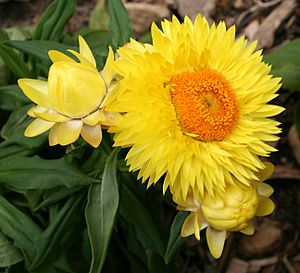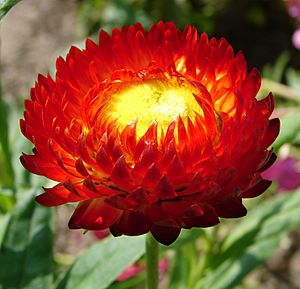Golden everlasting facts for kids
Quick facts for kids Golden everlasting |
|
|---|---|
 |
|
| Wild form of Xerochrysum bracteatum | |
| Scientific classification | |
| Kingdom: | |
| (unranked): | |
| (unranked): | |
| (unranked): | |
| Order: | |
| Family: | |
| Genus: | |
| Binomial name | |
| Xerochrysum bracteatum |
|

Xerochrysum bracteatum is a beautiful flowering plant from Australia. It belongs to the daisy family, called Asteraceae. In English, people often call this plant the golden everlasting or strawflower.
This plant can grow as a shrub that lives for many years (a perennial) or just one year (an annual). It can reach up to a meter (about 3 feet) tall.
The golden everlasting is important for many insects. Its leaves are food for different kinds of larvae (caterpillars) of butterflies, moths, and skippers. Adult butterflies, hoverflies, native bees, small beetles, and grasshoppers love to visit its bright flowers. This plant is also quite easy to grow. You can find many types with different colored flowers.
Contents
Where Golden Everlasting Grows
The golden everlasting plant grows all over Australia. You can find it in every state and territory, including Tasmania. It is very common, from North Queensland all the way to Western Australia.
This plant can live in almost any habitat, as long as it's not too shady. In Central Australia, it grows as an annual plant in red sand. It quickly sprouts and grows after it rains. You can also find it near granite rocks in Western Australia. In the Sydney area, it grows in richer soils like those made from basalt, shale, or limestone. These areas usually have a lot of underground water. Sometimes, it even grows along roadsides and in fields in the New England region of the United States.
How Golden Everlasting Attracts Insects
The bright, colorful parts of the golden everlasting flower look like petals. These are actually special leaves called bracts. They help to attract insects like hoverflies, native bees, and small beetles. These insects then help the plant by carrying pollen from one flower to another. This process is called pollination. Grasshoppers also visit the flower heads.
Caterpillars of the Tebenna micalis moth and the Australian painted lady butterfly (Vanessa kershawi) eat this plant. The tiny seeds of the golden everlasting are carried by the wind. They usually sprout and grow after a fire or in areas where the ground has been disturbed.
Sometimes, golden everlasting plants can get sick. For example, a type of water mold called Bremia lactucae has infected these plants in Italy and California. This can cause spots on the leaves. Also, a tiny worm called a root-knot nematode can attack the roots. This makes lumps on the roots and can cause the plant to die.
Growing and Breeding Golden Everlasting
People started growing the golden everlasting in England by 1791. A German gardener named Herren Ebritsch began to grow and sell many different colored types of this plant in the 1850s. These new varieties had colors from bronze to white to purple. The early types often had bracts that stayed cupped around the flower, unlike the wild Australian plants. These were also annual plants, meaning they lived for only one year.
Many of these early types were given special names, like 'atrococcineum' (dark red flowers) or 'aureum' (golden yellow flowers). Today, you can often buy mixed seeds of these plants to grow as annuals. Some types of Helichrysum from South Africa were also used in breeding. This helped create the huge range of colors we see today. The golden everlasting became very popular with kings and queens in Europe in the early 1800s. However, it wasn't until the 1860s that it became popular in Australian gardens.
Most of the new types of golden everlasting created in Australia since the late 1900s are perennials. This means they live for many years. 'Dargan Hill Monarch' was one of the first of these. Now, there are many more, in colors like white, yellow, orange, pink, and red. They flower a lot and usually live for about three years.
A company called Aussie Winners has a group of smaller plants called Sundaze. These come in colors from orange to white and usually have bigger leaves. One of their plants, 'Florabella Gold', won an award in 1999 for being the best new potted plant. Other groups of these flowers include the Nullarbor series and Queensland Federation daisies.
Golden everlasting plants are easy to grow from both seeds and cuttings. If you want a specific type, it's best to use cuttings. Fresh seeds usually sprout in 3 to 20 days and don't need special care. These plants grow best in slightly acidic soil (pH 5.5 to 6.3) that drains well. They don't like too much phosphorus. If they don't get enough iron, their newest leaves might turn yellow while the veins stay green.
You can grow golden everlasting plants in large pots or window boxes. They are also good for planting in gardens before other plants grow bigger. Smaller types are great for hanging baskets and along garden edges. The flowers attract butterflies to your garden. Dried golden everlasting flowers last a very long time, sometimes for years! They are often used in flower arrangements and by florists.
Images for kids
See also
 In Spanish: Siempreviva para niños
In Spanish: Siempreviva para niños






